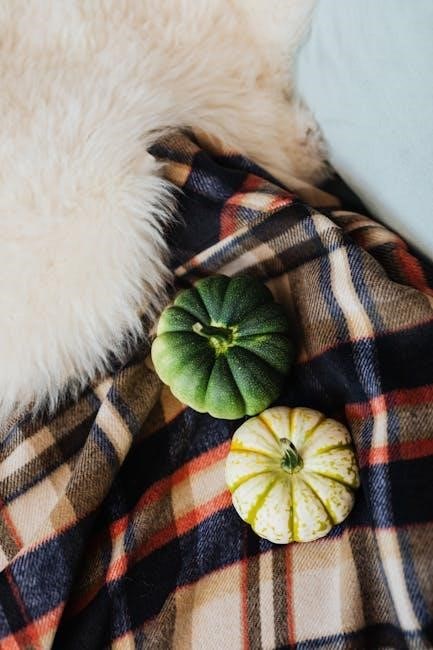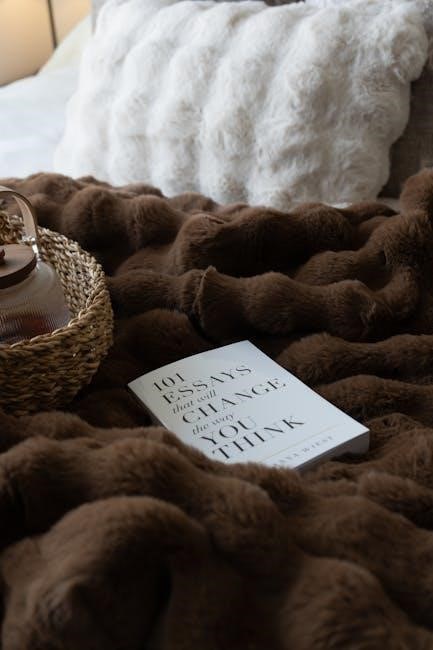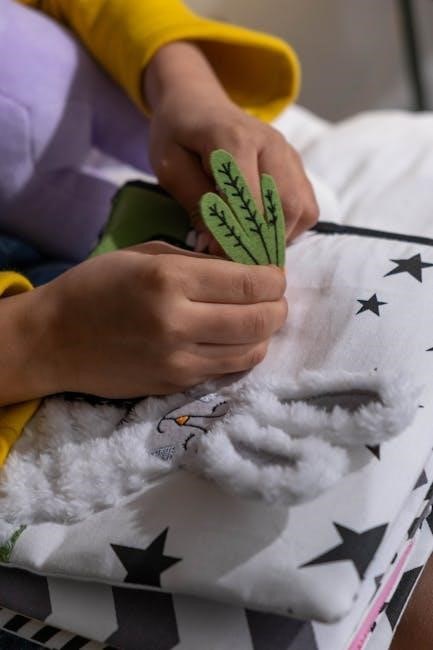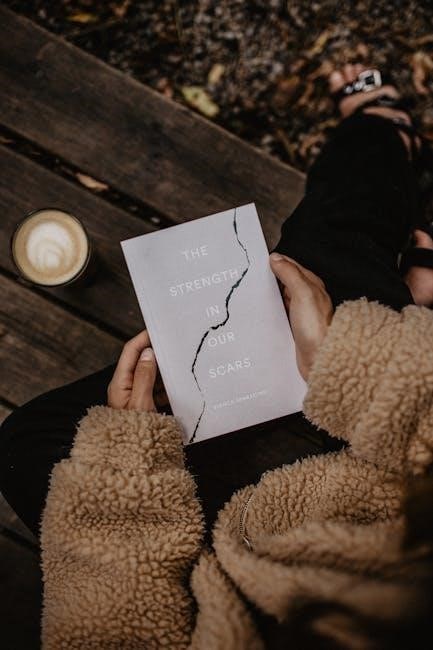No-sew fleece blankets are a popular DIY project requiring no sewing skills․ They’re easy to make, customizable, and perfect for gifts or home use, suitable for all ages․
1․1 What is a No-Sew Fleece Blanket?
A no-sew fleece blanket is a simple DIY project that requires no sewing machine or needles․ It’s made by cutting and tying fringe from two layers of fleece fabric, creating a soft, cozy blanket․ The process involves aligning two pieces of fleece, cutting strips around the edges, and tying knots to secure the layers together․ This method is perfect for beginners, as it requires minimal tools and time․ The result is a warm, lightweight blanket that’s ideal for personal use, gifts, or charity projects․ The ease of customization allows for various sizes, patterns, and colors, making it a versatile and enjoyable craft for all skill levels․ The no-sew technique ensures durability and a professional finish without the need for advanced sewing skills․
1․2 Benefits of Making One
Making a no-sew fleece blanket offers numerous benefits․ It’s a cost-effective and time-saving project, ideal for those with limited crafting experience․ The absence of sewing ensures it’s accessible to everyone, making it a great activity for family or group events․ Additionally, the blanket provides warmth and comfort, perfect for gifts, charity donations, or personal use․ The customization options allow for personalization, ensuring the blanket suits any preference or occasion․ Furthermore, the process is stress-free and enjoyable, fostering creativity without the pressure of complex techniques․ It’s also eco-friendly, utilizing fabric scraps and promoting sustainability․ The quick completion time makes it a satisfying project, providing a sense of accomplishment․ Overall, creating a no-sew fleece blanket is a practical, enjoyable, and rewarding endeavor with lasting benefits․
1․3 Brief History
The no-sew fleece blanket concept emerged as a practical crafting solution, evolving from traditional sewing methods․ Its origins trace back to the early 2000s when DIY projects gained popularity․ The idea gained traction due to its simplicity and accessibility, making it a favorite for community events and charity initiatives․ Over time, the technique has been refined, with tutorials and patterns widely shared online․ It became a staple in crafting circles, especially for beginners, and has since inspired countless variations․ Today, the no-sew fleece blanket remains a beloved project, cherished for its ease and the warmth it brings to both creators and recipients․
Materials and Tools Needed
To create a no-sew fleece blanket, you’ll need high-quality fleece fabric, sharp scissors, a rotary cutter, a cutting mat, and a ruler․ Optional tools include a template for precision cutting․
- Fleece fabric (two pieces of equal size)
- Sharp scissors or a rotary cutter
- Self-healing cutting mat
- Ruler or measuring tape
- June Tailor Shape Cut template (optional)
2․1 Fleece Fabric Requirements
Selecting the right fleece fabric is crucial for a successful no-sew blanket․ Anti-pill polar fleece is highly recommended for its softness and durability․ Choose a size that suits your needs, such as 58×54 inches for a standard blanket․ Ensure both pieces of fleece are the same size for consistency․ Consider the thickness and weight of the fabric, as thicker fleece provides more warmth․ Always check for sales or discounts at fabric stores to save money․ The fabric’s width, typically 50-60 inches, will determine how much you need․ For a personalized touch, pick patterns or colors that match your preferences or the recipient’s style․ High-quality fleece ensures a cozy and long-lasting blanket, making it worth the investment․

2․2 Essential Cutting Tools
To create a no-sew fleece blanket, you’ll need a few essential cutting tools․ A sharp pair of fabric scissors is a must for trimming edges and cutting fringe․ A rotary cutter and mat are highly recommended for precise, smooth cuts, especially when working with large pieces of fleece․ A long ruler or measuring tape is necessary for accurate measurements and aligning the fabric․ Additionally, a June Tailor Shape Cut template can be used to ensure uniform fringe cuts, making the process easier and faster․ These tools will help you achieve clean, even edges and a professional-looking finish․ Always use caution when handling sharp objects and ensure your workspace is clear of distractions․ Proper tools make the cutting process efficient and enjoyable, leading to a beautifully crafted blanket․
2․3 Additional Accessories
While essential tools are necessary, additional accessories can enhance your no-sew fleece blanket-making experience․ A self-healing cutting mat provides a durable, protective surface for cutting, preventing damage to your work surface․ Pins can help keep layers of fleece aligned, ensuring straight cuts and even fringe․ A tape measure is useful for measuring fabric lengths and widths accurately․ Optional items like a fringe template or pattern can add consistency to your fringe cuts․ For tying knots, a sturdy pair of gloves can reduce hand strain․ These accessories make the process more efficient and comfortable, allowing you to focus on creating a cozy, high-quality blanket․ They are not mandatory but can significantly improve your crafting experience and the final product’s appearance․
Step-by-Step Guide
Prepare the fleece, cut it to size, create a fringe, and tie knots to secure the edges․ This simple, no-sew method ensures a cozy and personalized blanket․

3․1 Preparing the Fleece
Begin by laying the fleece fabric on a flat surface, ensuring it is smooth and wrinkle-free․ Trim the selvage edges using sharp scissors or a rotary cutter for a clean finish․ If using two pieces, stack them together, aligning the edges carefully․ This step ensures even cutting and a professional look for your no-sew blanket․ Remove any uneven edges and square the corners to maintain consistency․ Proper preparation is key for a successful project․
3․2 Cutting the Fleece to Size
Once the fleece is prepared, use sharp scissors or a rotary cutter to cut it to the desired size․ Place the fabric on a flat surface and smooth out any wrinkles․ Measure carefully to ensure even edges․ If using two pieces, stack them together and cut simultaneously for consistency․ Trim selvage edges and square the corners to prevent fraying․ For a standard blanket, cut the fleece to a rectangle, leaving a 4-inch border around the edges for the fringe․ Use a ruler or cutting mat to guide your cuts and ensure straight lines․ This step is crucial for achieving a professional finish․ Avoid uneven cuts, as they can affect the final appearance of the blanket․
3․3 Creating the Fringe
To create the fringe, cut 1-inch wide strips along all four sides of the fleece․ Use a rotary cutter and mat or sharp scissors for clean cuts․ Start by cutting through both layers of fleece at the edges, spacing the strips evenly․ Make sure not to cut too close to the corners, as this can cause the fringe to unravel․ Once the strips are cut, tie knots using one strip from the front and one from the back․ This creates a secure and decorative edge․ Avoid tying two strips from the same side, as it may leave loose ends․ Work your way around the blanket, tying knots tightly but not too tightly to avoid puckering the fabric․ Use a consistent pattern to ensure a uniform look․ This step adds the finishing touch to your no-sew fleece blanket․

Tips and Tricks
Use a rotary cutter for precise cuts, choose coordinating colors, and maintain consistent fringe width․ Avoid uneven edges and ensure knots are securely tied for a polished finish․
4․1 Avoiding Mistakes
To ensure your no-sew fleece blanket turns out perfectly, avoid common mistakes like uneven cuts or mismatched fringe widths․ Always use a rotary cutter and mat for precise cuts, and trim selvage edges before starting․ Lay both fleece pieces together to maintain alignment, and cut fringe in consistent widths․ Tie knots tightly to prevent them from coming undone, and avoid overlapping fringe strips․ For best results, pin fabric together while cutting to keep it stable․ Additionally, use a ruler to guide your cuts, especially when trimming corners․ By following these tips, you can create a professional-looking blanket with minimal effort․ Proper preparation and attention to detail will make your project enjoyable and successful․
4․2 Choosing Patterns
When making a no-sew fleece blanket, selecting the right pattern is key to achieving a desired look․ Solid colors offer a sleek, timeless appearance, while vibrant prints add personality․ Seasonal themes, like holiday motifs or sports team logos, make great gifts․ For kids, fun designs such as cartoons or animals are ideal․ Consider mixing complementary patterns on front and back for a unique touch․ Ensure the fleece width matches your project size, typically 50-60 inches․ Use templates or guides to align patterns evenly․ For a cohesive look, choose colors that match the recipient’s preferences or home decor․ Patterns can also reflect personal interests, making the blanket more meaningful․ Always check fabric quality to ensure softness and durability․ By thoughtfully selecting patterns, you can create a blanket that’s both functional and visually appealing․
4․3 Working Efficiently
Efficiency is key when making a no-sew fleece blanket․ Start by gathering all tools and materials beforehand․ Use a rotary cutter and mat for quick, precise cuts․ Lay both fleece layers wrong sides together and trim them simultaneously to save time․ Cut fringe uniformly, ensuring strips are consistent in width․ Tying knots as you go prevents tangles and saves effort․ Work in a distraction-free area to maintain focus․ For larger blankets, consider cutting fringe in sections to avoid overwhelm․ Keep the workspace clean to prevent losing small fabric strips․ By staying organized and methodical, you can complete the project efficiently, even if working in shorter sessions․ Proper planning and smooth execution ensure a beautiful, cozy blanket with minimal stress․

Customization Ideas
Customize your no-sew fleece blanket with size variations, theme ideas, and embellishments․ Choose patterns, colors, and personalized touches to match preferences or special occasions, making it uniquely yours․
5․1 Size Variations
No-sew fleece blankets can be made in various sizes to suit different needs․ Common sizes include baby blankets (30×40 inches), lap blankets (30×50 inches), and full-size blankets (50×60 inches)․ The size depends on the intended use and the recipient․ Fleece fabric typically comes in 60-inch widths, making it easy to adjust dimensions․ For a larger blanket, use more fabric, while smaller projects require less material․ Some patterns even offer pre-cut kits for specific sizes, simplifying the process․ Always consider the purpose and the person’s preferences when choosing the size․ This versatility makes no-sew fleece blankets adaptable for gifts, home decor, or charity donations․
5․2 Theme Ideas
No-sew fleece blankets can be personalized with various themes to match preferences or occasions․ Popular options include sports team logos, holiday patterns, and children’s favorite characters․ Solid colors are also a timeless choice․ For a personalized touch, consider matching the recipient’s favorite hues or interests․ Seasonal themes, like snowflakes for winter or pumpkins for fall, add festive charm․ Baby blankets can feature adorable animal prints or soft pastels․ Additionally, using themed fleece with patterns like superheroes or unicorns can make the blanket more appealing to kids․ The versatility of fleece allows for endless creativity, ensuring the blanket reflects the recipient’s personality or celebrates a special event․ This customization makes no-sew fleece blankets thoughtful and unique gifts for any age or occasion․
5․3 Embellishments
Embellishments can add a personal touch to your no-sew fleece blanket․ Consider adding iron-on transfers, fabric paint, or appliques to create unique designs․ Ribbons or bows tied into the fringe can add a decorative finish․ For a more personalized look, use fabric markers to draw patterns or names directly onto the fleece․ Some crafters also use no-sew fabric glue to attach pre-made decorative elements like sequins or patches․ These additions make the blanket more special and tailored to the recipient’s preferences․ However, keep embellishments simple to maintain the blanket’s softness and functionality․ With creativity, you can turn a basic no-sew fleece blanket into a one-of-a-kind gift or keepsake․
Finishing the Blanket
Tie knots securely along the fringe to complete the blanket․ Inspect edges for evenness and trim excess fabric․ Your no-sew fleece blanket is now ready for use or gifting․

6․1 Tying Knots
Tying knots is the final step in securing the fringe of your no-sew fleece blanket․ To achieve a neat finish, take one strip from the front and another from the back, tying them together in an overhand knot close to the edge․ Ensure the knots are tight to prevent fraying․ This method creates a polished look․ For consistency, maintain uniform knot spacing around the blanket․ If needed, trim excess fringe for a tidy appearance․ Proper knot-tying ensures durability and a professional finish․
6․2 Inspecting the Edges
After tying the knots, inspect the edges of the blanket to ensure a polished finish․ Check for loose threads or uneven fringe, trimming any excess with scissors or a rotary cutter․ Verify that the selvage edges are removed and the corners are square․ Make sure the fringe is uniform in length and evenly spaced․ If necessary, trim stray fibers to achieve a clean look․ This step ensures the blanket’s edges are professional and visually appealing․ Proper inspection guarantees durability and a neat appearance, making the blanket ready for use or gifting․ Attention to detail here is key to a high-quality finish․ Always review your work before declaring the blanket complete, as this final check ensures satisfaction with the result․
6․3 Final Touches
Once the knots are secure and edges are inspected, give the blanket a final fluff to ensure the fleece lies flat and the fringe is evenly spread․ Smooth out any wrinkles or tangles in the fabric․ Double-check for any missed knots or uneven ties, making adjustments as needed․ For a professional finish, trim any stray fibers or excess thread․ If desired, fold the blanket neatly or roll it for storage or gifting․ Your no-sew fleece blanket is now complete and ready to use or share․ Take pride in your handmade creation, knowing it provides warmth and comfort․ This final step ensures your blanket looks polished and well-crafted, making it a thoughtful and cozy addition to any home․

Care and Maintenance
Wash the blanket in cold water, avoid fabric softeners, and tumble dry on low․ Store in a dry place to prevent moisture buildup and maintain softness․
7․1 Washing Instructions

To maintain the softness and quality of your no-sew fleece blanket, wash it in cold water using a mild detergent․ Avoid using fabric softeners or bleach, as they can damage the fleece fibers․ Gently cycle is recommended․ Before washing, check the care label on the fleece for specific instructions․ If hand washing, rinse thoroughly and gently squeeze out excess water․ For machine washing, place the blanket in a mesh laundry bag to protect it from friction․ Do not overload the washer․ After washing, remove promptly and reshape the blanket while it’s damp to maintain its size․ Air drying is best, but if using a dryer, use a low heat setting and remove as soon as the cycle ends to prevent shrinking․ Regular washing will keep your blanket clean and cozy for years to come․
7․2 Drying Tips
Proper drying is essential to maintain the softness and texture of your no-sew fleece blanket․ Air drying is recommended to prevent shrinking and damage․ Lay the blanket flat on a clean, dry surface, reshaping it to its original dimensions while still damp․ If using a dryer, set it to a low heat cycle and remove the blanket as soon as the cycle ends to avoid wrinkles․ Do not leave it in the dryer to cool, as this can cause pilling or shrinkage․ Avoid using fabric softener sheets, as they can reduce the blanket’s softness over time․ For best results, hang the blanket to air dry, especially if it has fringe, to prevent tangling․ Regular drying tips will ensure your fleece blanket remains cozy and durable for years to come․
7․3 Storage Advice
Proper storage ensures your no-sew fleece blanket remains in excellent condition․ Store it in a cool, dry place away from direct sunlight to prevent fading․ Folding the blanket neatly is ideal, but avoid creasing it tightly for long periods, as this can cause permanent folds․ Alternatively, hang the blanket on a sturdy hanger or lay it flat in a drawer․ If storing for an extended time, consider placing it in a breathable fabric bag or a plastic storage bin to protect it from dust․ Keeping it away from pets and moisture will prevent damage․ Regularly airing out the blanket can maintain its freshness․ By following these storage tips, your no-sew fleece blanket will stay soft, intact, and ready for use whenever needed․
No-sew fleece blankets are a simple, rewarding DIY project․ For more guidance, explore tutorials from Bunyworks․net or Project Linus, which offer detailed instructions and creative variations for all skill levels․
8․1 Final Thoughts
Creating a no-sew fleece blanket is a fun and easy project that offers a sense of accomplishment․ With minimal tools and no sewing required, it’s perfect for beginners and experienced crafters alike․ The ability to customize sizes and patterns makes each blanket unique, allowing you to tailor it to personal preferences or specific needs․ Whether making one for yourself, as a gift, or for charitable causes, the process is both rewarding and straightforward․ The simplicity of the project ensures that anyone can participate, making it a great activity for families, groups, or individuals looking to create something meaningful without the need for advanced skills․ The end result is a warm, cozy blanket that provides comfort and serves as a thoughtful gesture․
8․2 Finding More Tutorials

For those seeking additional guidance, numerous tutorials and resources are available online․ Websites like Bunyworks․net and Project Linus offer detailed step-by-step instructions, while platforms like YouTube provide video tutorials for visual learners․ Many fabric stores and crafting communities also share free PDF guides, making it easy to find a method that suits your preferences․ These resources often include tips for customizing your blanket and troubleshooting common issues․ Additionally, social media groups and forums dedicated to DIY projects frequently feature no-sew fleece blanket tutorials, allowing you to connect with others who share your interests․ With so many resources at your fingertips, you can refine your skills and explore new ideas to create even more personalized blankets․ Whether you’re a beginner or looking to improve your technique, there’s a wealth of information available to help you succeed․

8․3 Online Communities
Online communities are a fantastic resource for connecting with crafters who share your passion for no-sew fleece blankets․ Platforms like Facebook and Reddit host groups dedicated to DIY projects, where members exchange ideas, share photos of their work, and offer advice․ These communities are particularly helpful for troubleshooting common issues or gaining inspiration for new designs․ Additionally, forums like Pinterest and Instagram are filled with visual tutorials and examples, making it easy to find motivation and guidance․ Many participants also share their personal tips and favorite patterns, allowing you to learn from their experiences․ By joining these online communities, you can expand your creativity, solve challenges, and connect with like-minded individuals who enjoy crafting no-sew fleece blankets․ This collaborative environment fosters growth and ensures you never run out of fresh ideas for your projects․
